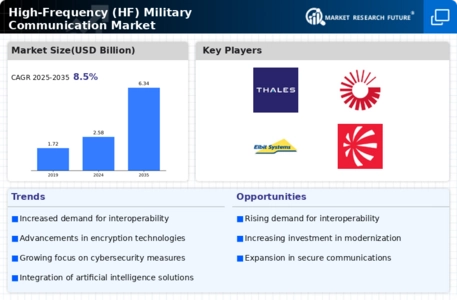-
EXECUTIVE SUMMARY
-
MARKET INTRODUCTION
-
Definition
-
Scope of the Study
- Research Objective
- Assumptions
- Limitations
-
RESEARCH METHODOLOGY
-
Overview
-
Data Mining
-
Secondary Research
-
Primary Research
- Primary Interviews and Information Gathering Process
- Breakdown of Primary Respondents
-
Forecasting Model
-
Market Size Estimation
- Bottom-Up Approach
- Top-Down Approach
-
Data Triangulation
-
Validation
-
MARKET DYNAMICS
-
Overview
-
Drivers
-
Restraints
-
Opportunities
-
MARKET FACTOR ANALYSIS
-
Value Chain Analysis
-
Porter’s Five Forces Analysis
- Bargaining Power of Suppliers
- Bargaining Power of Buyers
- Threat of New Entrants
- Threat of Substitutes
- Intensity of Rivalry
-
COVID-19 Impact Analysis
- Market Impact Analysis
- Regional Impact
- Opportunity and Threat Analysis
-
GLOBAL HIGH-FREQUENCY (HF) MILITARY COMMUNICATION MARKET, BY FREQUENCY RANGE
-
Overview
-
18-20 MHz
-
20-22 MHz
-
22-25 MHz
-
25-30 MHz
-
GLOBAL HIGH-FREQUENCY (HF) MILITARY COMMUNICATION MARKET, BY PLATFORM
-
Overview
-
Land
-
Naval
-
Airborne
-
GLOBAL HIGH-FREQUENCY (HF) MILITARY COMMUNICATION MARKET, BY COMPONENT
-
Overview
-
Hardware
-
Software
-
GLOBAL HIGH-FREQUENCY (HF) MILITARY COMMUNICATION MARKET, BY APPLICATION
-
Overview
-
Command & Control
-
Intelligence, Surveillance, reconnaissance
-
Routine operations
-
Others
-
GLOBAL HIGH-FREQUENCY (HF) MILITARY COMMUNICATION MARKET, BY REGION
-
Overview
-
North America
- US
- Canada
-
Europe
- Germany
- France
- UK
- Italy
- Spain
- Rest of Europe
-
Asia-Pacific
- China
- India
- Japan
- South Korea
- Australia
- Rest of Asia-Pacific
-
Rest of the World
- Middle East
- Africa
- Latin America
-
COMPETITIVE LANDSCAPE
-
Overview
-
Competitive Analysis
-
Market Share Analysis
-
Major Growth Strategy in the Global High-Frequency (HF) Military Communication Market,
-
Competitive Benchmarking
-
Leading Players in Terms of Number of Developments in the Global High-Frequency (HF) Military Communication Market,
-
Key developments and Growth Strategies
- New Product Launch/Service Deployment
- Merger & Acquisitions
- Joint Ventures
-
Major Players Financial Matrix
- Sales & Operating Income, 2024
- Major Players R&D Expenditure. 2024
-
COMPANY PROFILES
-
Harris Corporation (L3Harris Technologies)
- Company Overview
- Financial Overview
- Products Offered
- Key Developments
- SWOT Analysis
- Key Strategies
-
Thales Group
- Company Overview
- Financial Overview
- Products Offered
- Key Developments
- SWOT Analysis
- Key Strategies
-
Collins Aerospace (formerly Rockwell Collins)
- Company Overview
- Financial Overview
- Products Offered
- Key Developments
- SWOT Analysis
- Key Strategies
-
Elbit Systems
- Company Overview
- Financial Overview
- Products Offered
- Key Developments
- SWOT Analysis
- Key Strategies
-
Leonardo DRS
- Company Overview
- Financial Overview
- Products Offered
- Key Developments
- SWOT Analysis
- Key Strategies
-
APPENDIX
-
References
-
Related Reports
-
-
LIST OF TABLES
-
GLOBAL HIGH-FREQUENCY (HF) MILITARY COMMUNICATION MARKET, SYNOPSIS, 2018-2032
-
GLOBAL HIGH-FREQUENCY (HF) MILITARY COMMUNICATION MARKET, ESTIMATES & FORECAST, 2025-2034(USD BILLION)
-
GLOBAL HIGH-FREQUENCY (HF) MILITARY COMMUNICATION MARKET, BY FREQUENCY RANGE, 2025-2034(USD BILLION)
-
GLOBAL HIGH-FREQUENCY (HF) MILITARY COMMUNICATION MARKET, BY PLATFORM, 2025-2034(USD BILLION)
-
GLOBAL HIGH-FREQUENCY (HF) MILITARY COMMUNICATION MARKET, BY COMPONENT, 2025-2034(USD BILLION)
-
GLOBAL HIGH-FREQUENCY (HF) MILITARY COMMUNICATION MARKET, BY APPLICATION, 2025-2034(USD BILLION)
-
NORTH AMERICA: HIGH-FREQUENCY (HF) MILITARY COMMUNICATION MARKET, BY FREQUENCY RANGE, 2025-2034(USD BILLION)
-
NORTH AMERICA: HIGH-FREQUENCY (HF) MILITARY COMMUNICATION MARKET, BY PLATFORM, 2025-2034(USD BILLION)
-
NORTH AMERICA: HIGH-FREQUENCY (HF) MILITARY COMMUNICATION MARKET, BY COMPONENT, 2025-2034(USD BILLION)
-
NORTH AMERICA: HIGH-FREQUENCY (HF) MILITARY COMMUNICATION MARKET, BY APPLICATION, 2025-2034(USD BILLION)
-
US: HIGH-FREQUENCY (HF) MILITARY COMMUNICATION MARKET, BY FREQUENCY RANGE, 2025-2034(USD BILLION)
-
US: HIGH-FREQUENCY (HF) MILITARY COMMUNICATION MARKET, BY PLATFORM, 2025-2034(USD BILLION)
-
US: HIGH-FREQUENCY (HF) MILITARY COMMUNICATION MARKET, BY COMPONENT, 2025-2034(USD BILLION)
-
US: HIGH-FREQUENCY (HF) MILITARY COMMUNICATION MARKET, BY APPLICATION, 2025-2034(USD BILLION)
-
CANADA: HIGH-FREQUENCY (HF) MILITARY COMMUNICATION MARKET, BY FREQUENCY RANGE, 2025-2034(USD BILLION)
-
CANADA: HIGH-FREQUENCY (HF) MILITARY COMMUNICATION MARKET, BY PLATFORM, 2025-2034(USD BILLION)
-
CANADA: HIGH-FREQUENCY (HF) MILITARY COMMUNICATION MARKET, BY COMPONENT, 2025-2034(USD BILLION)
-
CANADA: HIGH-FREQUENCY (HF) MILITARY COMMUNICATION MARKET, BY APPLICATION, 2025-2034(USD BILLION)
-
EUROPE: HIGH-FREQUENCY (HF) MILITARY COMMUNICATION MARKET, BY FREQUENCY RANGE, 2025-2034(USD BILLION)
-
EUROPE: HIGH-FREQUENCY (HF) MILITARY COMMUNICATION MARKET, BY PLATFORM, 2025-2034(USD BILLION)
-
EUROPE: HIGH-FREQUENCY (HF) MILITARY COMMUNICATION MARKET, BY COMPONENT, 2025-2034(USD BILLION)
-
EUROPE: HIGH-FREQUENCY (HF) MILITARY COMMUNICATION MARKET, BY APPLICATION, 2025-2034(USD BILLION)
-
GERMANY: HIGH-FREQUENCY (HF) MILITARY COMMUNICATION MARKET, BY FREQUENCY RANGE, 2025-2034(USD BILLION)
-
GERMANY: HIGH-FREQUENCY (HF) MILITARY COMMUNICATION MARKET, BY PLATFORM, 2025-2034(USD BILLION)
-
GERMANY: HIGH-FREQUENCY (HF) MILITARY COMMUNICATION MARKET, BY COMPONENT, 2025-2034(USD BILLION)
-
GERMANY: HIGH-FREQUENCY (HF) MILITARY COMMUNICATION MARKET, BY APPLICATION, 2025-2034(USD BILLION)
-
FRANCE: HIGH-FREQUENCY (HF) MILITARY COMMUNICATION MARKET, BY FREQUENCY RANGE, 2025-2034(USD BILLION)
-
FRANCE: HIGH-FREQUENCY (HF) MILITARY COMMUNICATION MARKET, BY PLATFORM, 2025-2034(USD BILLION)
-
FRANCE: HIGH-FREQUENCY (HF) MILITARY COMMUNICATION MARKET, BY COMPONENT, 2025-2034(USD BILLION)
-
FRANCE: HIGH-FREQUENCY (HF) MILITARY COMMUNICATION MARKET, BY APPLICATION, 2025-2034(USD BILLION)
-
ITALY: HIGH-FREQUENCY (HF) MILITARY COMMUNICATION MARKET, BY FREQUENCY RANGE, 2025-2034(USD BILLION)
-
ITALY: HIGH-FREQUENCY (HF) MILITARY COMMUNICATION MARKET, BY PLATFORM, 2025-2034(USD BILLION)
-
ITALY: HIGH-FREQUENCY (HF) MILITARY COMMUNICATION MARKET, BY COMPONENT, 2025-2034(USD BILLION)
-
ITALY: HIGH-FREQUENCY (HF) MILITARY COMMUNICATION MARKET, BY APPLICATION, 2025-2034(USD BILLION)
-
SPAIN: HIGH-FREQUENCY (HF) MILITARY COMMUNICATION MARKET, BY FREQUENCY RANGE, 2025-2034(USD BILLION)
-
SPAIN: HIGH-FREQUENCY (HF) MILITARY COMMUNICATION MARKET, BY PLATFORM, 2025-2034(USD BILLION)
-
SPAIN: HIGH-FREQUENCY (HF) MILITARY COMMUNICATION MARKET, BY COMPONENT, 2025-2034(USD BILLION)
-
SPAIN: HIGH-FREQUENCY (HF) MILITARY COMMUNICATION MARKET, BY APPLICATION, 2025-2034(USD BILLION)
-
UK: HIGH-FREQUENCY (HF) MILITARY COMMUNICATION MARKET, BY FREQUENCY RANGE, 2025-2034(USD BILLION)
-
UK: HIGH-FREQUENCY (HF) MILITARY COMMUNICATION MARKET, BY PLATFORM, 2025-2034(USD BILLION)
-
UK: HIGH-FREQUENCY (HF) MILITARY COMMUNICATION MARKET, BY COMPONENT, 2025-2034(USD BILLION)
-
UK: HIGH-FREQUENCY (HF) MILITARY COMMUNICATION MARKET, BY APPLICATION, 2025-2034(USD BILLION)
-
REST OF EUROPE: HIGH-FREQUENCY (HF) MILITARY COMMUNICATION MARKET, BY FREQUENCY RANGE, 2025-2034(USD BILLION)
-
REST OF EUROPE: HIGH-FREQUENCY (HF) MILITARY COMMUNICATION MARKET, BY PLATFORM, 2025-2034(USD BILLION)
-
REST OF EUROPE: HIGH-FREQUENCY (HF) MILITARY COMMUNICATION MARKET, BY COMPONENT, 2025-2034(USD BILLION)
-
REST OF EUROPE: HIGH-FREQUENCY (HF) MILITARY COMMUNICATION MARKET, BY APPLICATION, 2025-2034(USD BILLION)
-
ASIA-PACIFIC: HIGH-FREQUENCY (HF) MILITARY COMMUNICATION MARKET, BY FREQUENCY RANGE, 2025-2034(USD BILLION)
-
ASIA-PACIFIC: HIGH-FREQUENCY (HF) MILITARY COMMUNICATION MARKET, BY PLATFORM, 2025-2034(USD BILLION)
-
ASIA-PACIFIC: HIGH-FREQUENCY (HF) MILITARY COMMUNICATION MARKET, BY COMPONENT, 2025-2034(USD BILLION)
-
ASIA-PACIFIC: HIGH-FREQUENCY (HF) MILITARY COMMUNICATION MARKET, BY APPLICATION, 2025-2034(USD BILLION)
-
JAPAN: HIGH-FREQUENCY (HF) MILITARY COMMUNICATION MARKET, BY FREQUENCY RANGE, 2025-2034(USD BILLION)
-
JAPAN: HIGH-FREQUENCY (HF) MILITARY COMMUNICATION MARKET, BY PLATFORM, 2025-2034(USD BILLION)
-
JAPAN: HIGH-FREQUENCY (HF) MILITARY COMMUNICATION MARKET, BY COMPONENT, 2025-2034(USD BILLION)
-
JAPAN: HIGH-FREQUENCY (HF) MILITARY COMMUNICATION MARKET, BY APPLICATION, 2025-2034(USD BILLION)
-
CHINA: HIGH-FREQUENCY (HF) MILITARY COMMUNICATION MARKET, BY FREQUENCY RANGE, 2025-2034(USD BILLION)
-
CHINA: HIGH-FREQUENCY (HF) MILITARY COMMUNICATION MARKET, BY PLATFORM, 2025-2034(USD BILLION)
-
CHINA: HIGH-FREQUENCY (HF) MILITARY COMMUNICATION MARKET, BY COMPONENT, 2025-2034(USD BILLION)
-
CHINA: HIGH-FREQUENCY (HF) MILITARY COMMUNICATION MARKET, BY APPLICATION, 2025-2034(USD BILLION)
-
INDIA: HIGH-FREQUENCY (HF) MILITARY COMMUNICATION MARKET, BY FREQUENCY RANGE, 2025-2034(USD BILLION)
-
INDIA: HIGH-FREQUENCY (HF) MILITARY COMMUNICATION MARKET, BY PLATFORM, 2025-2034(USD BILLION)
-
INDIA: HIGH-FREQUENCY (HF) MILITARY COMMUNICATION MARKET, BY COMPONENT, 2025-2034(USD BILLION)
-
INDIA: HIGH-FREQUENCY (HF) MILITARY COMMUNICATION MARKET, BY APPLICATION, 2025-2034(USD BILLION)
-
AUSTRALIA: HIGH-FREQUENCY (HF) MILITARY COMMUNICATION MARKET, BY FREQUENCY RANGE, 2025-2034(USD BILLION)
-
AUSTRALIA: HIGH-FREQUENCY (HF) MILITARY COMMUNICATION MARKET, BY PLATFORM, 2025-2034(USD BILLION)
-
AUSTRALIA: HIGH-FREQUENCY (HF) MILITARY COMMUNICATION MARKET, BY COMPONENT, 2025-2034(USD BILLION)
-
AUSTRALIA: HIGH-FREQUENCY (HF) MILITARY COMMUNICATION MARKET, BY APPLICATION, 2025-2034(USD BILLION)
-
SOUTH KOREA: HIGH-FREQUENCY (HF) MILITARY COMMUNICATION MARKET, BY FREQUENCY RANGE, 2025-2034(USD BILLION)
-
SOUTH KOREA: HIGH-FREQUENCY (HF) MILITARY COMMUNICATION MARKET, BY PLATFORM, 2025-2034(USD BILLION)
-
SOUTH KOREA: HIGH-FREQUENCY (HF) MILITARY COMMUNICATION MARKET, BY COMPONENT, 2025-2034(USD BILLION)
-
SOUTH KOREA: HIGH-FREQUENCY (HF) MILITARY COMMUNICATION MARKET, BY APPLICATION, 2025-2034(USD BILLION)
-
REST OF ASIA-PACIFIC: HIGH-FREQUENCY (HF) MILITARY COMMUNICATION MARKET, BY FREQUENCY RANGE, 2025-2034(USD BILLION)
-
REST OF ASIA-PACIFIC: HIGH-FREQUENCY (HF) MILITARY COMMUNICATION MARKET, BY PLATFORM, 2025-2034(USD BILLION)
-
REST OF ASIA-PACIFIC: HIGH-FREQUENCY (HF) MILITARY COMMUNICATION MARKET, BY COMPONENT, 2025-2034(USD BILLION)
-
REST OF ASIA-PACIFIC: HIGH-FREQUENCY (HF) MILITARY COMMUNICATION MARKET, BY APPLICATION, 2025-2034(USD BILLION)
-
REST OF THE WORLD: HIGH-FREQUENCY (HF) MILITARY COMMUNICATION MARKET, BY FREQUENCY RANGE, 2025-2034(USD BILLION)
-
REST OF THE WORLD: HIGH-FREQUENCY (HF) MILITARY COMMUNICATION MARKET, BY PLATFORM, 2025-2034(USD BILLION)
-
REST OF THE WORLD: HIGH-FREQUENCY (HF) MILITARY COMMUNICATION MARKET, BY COMPONENT, 2025-2034(USD BILLION)
-
REST OF THE WORLD: HIGH-FREQUENCY (HF) MILITARY COMMUNICATION MARKET, BY APPLICATION, 2025-2034(USD BILLION)
-
MIDDLE EAST: HIGH-FREQUENCY (HF) MILITARY COMMUNICATION MARKET, BY FREQUENCY RANGE, 2025-2034(USD BILLION)
-
MIDDLE EAST: HIGH-FREQUENCY (HF) MILITARY COMMUNICATION MARKET, BY PLATFORM, 2025-2034(USD BILLION)
-
MIDDLE EAST: HIGH-FREQUENCY (HF) MILITARY COMMUNICATION MARKET, BY COMPONENT, 2025-2034(USD BILLION)
-
MIDDLE EAST: HIGH-FREQUENCY (HF) MILITARY COMMUNICATION MARKET, BY APPLICATION, 2025-2034(USD BILLION)
-
AFRICA: HIGH-FREQUENCY (HF) MILITARY COMMUNICATION MARKET, BY FREQUENCY RANGE, 2025-2034(USD BILLION)
-
AFRICA: HIGH-FREQUENCY (HF) MILITARY COMMUNICATION MARKET, BY PLATFORM, 2025-2034(USD BILLION)
-
AFRICA: HIGH-FREQUENCY (HF) MILITARY COMMUNICATION MARKET, BY COMPONENT, 2025-2034(USD BILLION)
-
AFRICA: HIGH-FREQUENCY (HF) MILITARY COMMUNICATION MARKET, BY APPLICATION, 2025-2034(USD BILLION)
-
LATIN AMERICA: HIGH-FREQUENCY (HF) MILITARY COMMUNICATION MARKET, BY FREQUENCY RANGE, 2025-2034(USD BILLION)
-
LATIN AMERICA: HIGH-FREQUENCY (HF) MILITARY COMMUNICATION MARKET, BY PLATFORM, 2025-2034(USD BILLION)
-
LATIN AMERICA: HIGH-FREQUENCY (HF) MILITARY COMMUNICATION MARKET, BY COMPONENT, 2025-2034(USD BILLION)
-
LATIN AMERICA: HIGH-FREQUENCY (HF) MILITARY COMMUNICATION MARKET, BY APPLICATION, 2025-2034(USD BILLION)
-
LIST OF FIGURES
-
RESEARCH PROCESS
-
MARKET STRUCTURE FOR THE GLOBAL HIGH-FREQUENCY (HF) MILITARY COMMUNICATION MARKET
-
MARKET DYNAMICS FOR THE GLOBAL HIGH-FREQUENCY (HF) MILITARY COMMUNICATION MARKET
-
GLOBAL HIGH-FREQUENCY (HF) MILITARY COMMUNICATION MARKET, SHARE (%), BY FREQUENCY RANGE, 2024
-
GLOBAL HIGH-FREQUENCY (HF) MILITARY COMMUNICATION MARKET, SHARE (%), BY PLATFORM, 2024
-
GLOBAL HIGH-FREQUENCY (HF) MILITARY COMMUNICATION MARKET, SHARE (%), BY COMPONENT, 2024
-
GLOBAL HIGH-FREQUENCY (HF) MILITARY COMMUNICATION MARKET, SHARE (%), BY APPLICATION, 2024
-
GLOBAL HIGH-FREQUENCY (HF) MILITARY COMMUNICATION MARKET, SHARE (%), BY REGION, 2024
-
NORTH AMERICA: HIGH-FREQUENCY (HF) MILITARY COMMUNICATION MARKET, SHARE (%), BY REGION, 2024
-
EUROPE: HIGH-FREQUENCY (HF) MILITARY COMMUNICATION MARKET, SHARE (%), BY REGION, 2024
-
ASIA-PACIFIC: HIGH-FREQUENCY (HF) MILITARY COMMUNICATION MARKET, SHARE (%), BY REGION, 2024
-
REST OF THE WORLD: HIGH-FREQUENCY (HF) MILITARY COMMUNICATION MARKET, SHARE (%), BY REGION, 2024
-
GLOBAL HIGH-FREQUENCY (HF) MILITARY COMMUNICATION MARKET: COMPANY SHARE ANALYSIS, 2024 (%)
-
HARRIS CORPORATION (L3HARRIS TECHNOLOGIES): FINANCIAL OVERVIEW SNAPSHOT
-
HARRIS CORPORATION (L3HARRIS TECHNOLOGIES): SWOT ANALYSIS
-
THALES GROUP: FINANCIAL OVERVIEW SNAPSHOT
-
THALES GROUP: SWOT ANALYSIS
-
COLLINS AEROSPACE (FORMERLY ROCKWELL COLLINS): FINANCIAL OVERVIEW SNAPSHOT
-
COLLINS AEROSPACE (FORMERLY ROCKWELL COLLINS): SWOT ANALYSIS
-
ELBIT SYSTEMS.: FINANCIAL OVERVIEW SNAPSHOT
-
ELBIT SYSTEMS.: SWOT ANALYSIS
-
LEONARDO DRS: FINANCIAL OVERVIEW SNAPSHOT
-
LEONARDO DRS: SWOT ANALYSIS










Leave a Comment